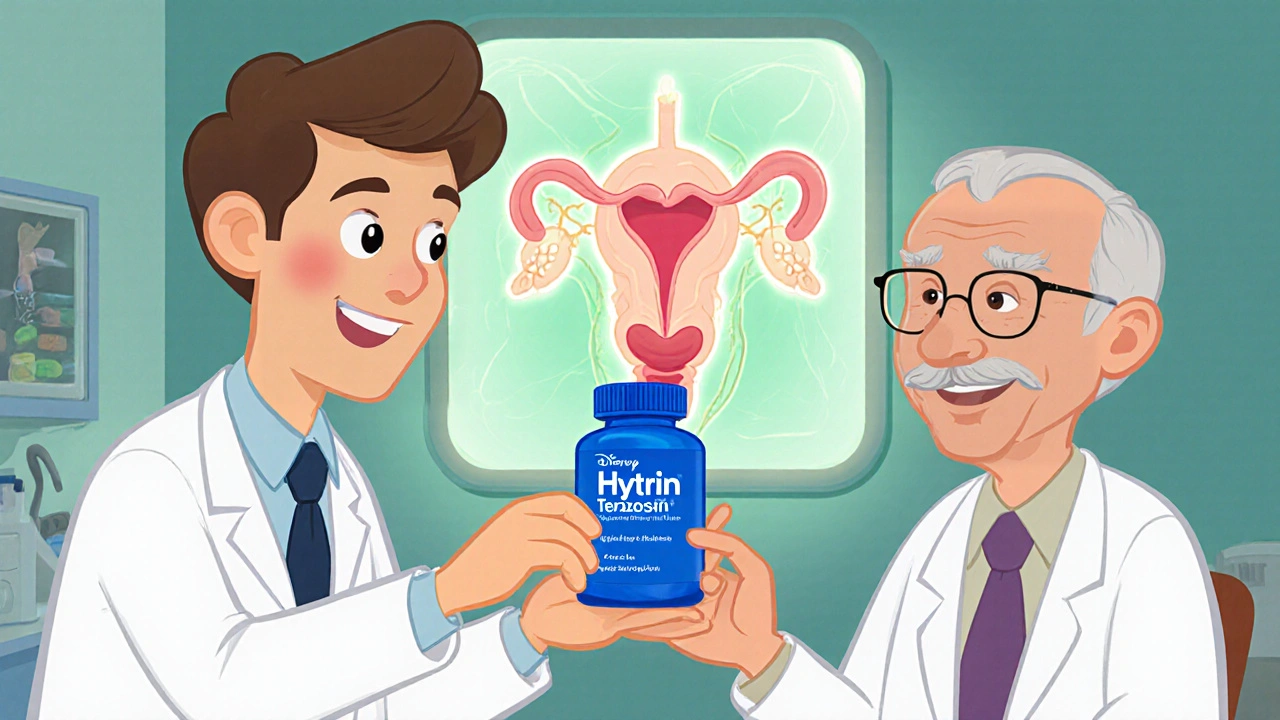Alpha-Blocker Selection Tool
Select Your Priorities
Answer a few questions to get personalized recommendations for your alpha-blocker choice.
Your Recommended Alpha-Blocker
Key Considerations
When doctors prescribe an alpha‑blocker for an enlarged prostate or high blood pressure, Terazosin often shows up first. But it’s not the only game‑in‑town. This guide lays out how Terazosin stacks up against the most common alternatives, what makes each drug tick, and which factors should steer your choice.
What is Terazosin (Hytrin)?
Terazosin is a prescription medication classified as a non‑selective alpha‑1 adrenergic receptor blocker. It was approved by the FDA in 1987 and is sold under the brand name Hytrin. By relaxing smooth muscle in blood vessels and the prostate, it lowers blood pressure and eases urinary flow in men with benign prostatic hyperplasia (BPH).
How Terazosin Works
Terazosin binds to alpha‑1 receptors found on the smooth muscle of the bladder neck, prostate, and arterial walls. When it blocks these receptors, the muscles relax, reducing the resistance to urine flow and dilating blood vessels, which in turn drops systolic and diastolic pressure. Because it’s non‑selective, it also hits alpha‑1 receptors in the eyes, sometimes causing mild visual changes.
Who Uses Terazosin?
- Benign Prostatic Hyperplasia - men over 50 who experience trouble starting urination, weak stream, or frequent nighttime bathroom trips.
- Hypertension - especially when a single drug isn’t enough to control blood pressure.
Doctors often start at a low dose (1 mg at bedtime) and titrate up to 10 mg daily, depending on response and side‑effect tolerance.
Benefits and Typical Dosing
For BPH, the usual dose is 1-5 mg once daily, taken at night to avoid morning dizziness. For hypertension, the dose may rise to 10 mg, split into one or two doses. The drug’s half‑life is about 12 hours, so once‑daily dosing works for most patients.

Common Side Effects & Warnings
Because Terazosin lowers blood pressure, the most frequent complaint is orthostatic hypotension - a sudden drop when standing that can cause light‑headedness or fainting. Other notable side effects include:
- Headache
- Dizziness
- Fatigue
- Nasopharyngitis
- Priapism (rare, but requires emergency care)
Patients with severe liver disease, heart failure, or a history of syncope should use extra caution, and doctors usually schedule the first dose at night.
Top Alternatives to Terazosin
When Terazosin’s side‑effect profile or dosing schedule isn’t ideal, clinicians turn to other alpha‑blockers that offer different selectivity, half‑life, or dosing convenience.
Doxazosin
Doxazosin is a long‑acting, non‑selective alpha‑1 blocker approved for both hypertension and BPH. It’s taken once daily, usually at bedtime, with a half‑life of 22 hours, giving smoother blood‑pressure control.
Tamsulosin
Tamsulosin is a uroselective alpha‑1A blocker, meaning it primarily targets prostate receptors while sparing blood‑vessel receptors. This selectivity reduces the risk of blood‑pressure‑related dizziness.
Alfuzosin
Alfuzosin is another uroselective agent, marketed for once‑daily use. It has a balanced affinity for all three alpha‑1 subtypes, offering a middle ground between selectivity and overall vascular effect.
Prazosin
Prazosin is primarily used for hypertension and post‑traumatic stress disorder (PTSD) nightmares, but it can also treat BPH. It’s shorter‑acting (half‑life ~2-3 hours) and often requires multiple daily doses.
Side‑Effect Profiles of the Alternatives
All alpha‑blockers share some common adverse events, yet their selectivity changes the odds of each:
- Doxazosin - higher incidence of hypotension and fluid retention.
- Tamsulosin - lower blood‑pressure effects but higher rates of ejaculatory dysfunction (retrograde ejaculation).
- Alfuzosin - moderate dizziness risk, moderate sexual side effects.
- Prazosin - “first‑dose” hypotension and nighttime vivid dreams.
Comparison Table: Terazosin vs Main Alternatives
| Drug | Primary Indications | Selectivity | Half‑Life | Typical Dose (BPH) | Common Side Effects |
|---|---|---|---|---|---|
| Terazosin | BPH, Hypertension | Non‑selective alpha‑1 | 12 h | 1-5 mg daily | Dizziness, headache, fatigue |
| Doxazosin | BPH, Hypertension | Non‑selective alpha‑1 | 22 h | 1-8 mg daily | Hypotension, fluid retention |
| Tamsulosin | BPH | Uroselective alpha‑1A | 9-13 h | 0.4 mg daily | Ejaculatory dysfunction, mild dizziness |
| Alfuzosin | BPH | Uroselective (balanced) | 8-10 h | 10 mg daily | Dizziness, nasal congestion |
| Prazosin | Hypertension, PTSD, BPH | Non‑selective alpha‑1 | 2-3 h | 1-5 mg three times daily | First‑dose hypotension, vivid dreams |

How to Choose the Right Alpha‑Blocker
Picking the best medication isn’t a one‑size‑fits‑all decision. Consider these practical factors:
- Blood‑pressure impact: If you have low baseline BP, a uroselective drug like Tamsulosin may spare you from dizziness.
- Sexual side effects: Men who value normal ejaculation often avoid Tamsulosin and choose Terazosin or Alfuzosin.
- Dosing convenience: Once‑daily agents (Terazosin, Doxazosin, Alfuzosin) suit busy schedules; Prazosin’s multiple doses can be cumbersome.
- Cost and insurance coverage: Generic Terazosin and Doxazosin are usually cheaper than brand‑only Tamsulosin.
- Kidney or liver function: Reduced metabolism may increase levels of longer‑acting drugs; a shorter‑acting agent could be safer.
Always discuss these points with your healthcare provider, who can weigh your medical history, current meds, and personal preferences.
Potential Drug Interactions
Alpha‑blockers can amplify the effects of other blood‑pressure‑lowering agents. Common culprits include:
- ACE inhibitors (e.g., lisinopril)
- Beta‑blockers (e.g., metoprolol)
- Phosphodiesterase‑5 inhibitors (e.g., sildenafil) - especially risky for sudden BP drops.
- Other vasodilators (e.g., nitroglycerin)
If you’re on any of these, your doctor may adjust the starting dose or monitor you more closely.
FAQ - Frequently Asked Questions
Can I switch from Terazosin to Tamsulosin without a washout period?
Usually yes. Because both drugs are alpha‑blockers, doctors often cross‑taper: they keep a low dose of Terazosin while starting Tamsulosin, then gradually discontinue Terazosin over 1-2 weeks. Always follow your prescriber’s titration schedule.
Why does Terazosin cause a “first‑dose” drop in blood pressure?
The drug’s effect peaks within 30‑60 minutes, relaxing blood vessels quickly. Starting at night reduces the risk of fainting, and doctors start with 1 mg to let your body adjust.
Is there a generic version of Tamsulosin?
Yes, several manufacturers sell generic Tamsulosin after the original patent expired in 2018. Prices are usually comparable to generic Terazosin, but check your pharmacy’s formulary.
Can I take Terazosin if I have a history of heart failure?
Caution is advised. While Terazosin can reduce afterload and benefit some heart‑failure patients, it may also trigger sudden drops in BP. Your cardiologist should decide if the benefits outweigh the risks.
Do any of these drugs interact with over‑the‑counter supplements?
Herbal products that lower blood pressure, such as garlic, ginkgo, or hawthorn, can amplify the effect of alpha‑blockers. Always tell your pharmacist about any supplements you take.
Bottom Line
Terazosin remains a solid first‑line choice for both BPH and hypertension because it’s affordable and effective. However, if dizziness or sexual side effects are a deal‑breaker, uroselective options like Tamsulosin or Alfuzosin may suit you better. The final decision hinges on your health profile, lifestyle, and cost considerations-so keep an open dialogue with your clinician.


Kelly Brammer
October 22, 2025
It is ethically indefensible to overlook the potential for orthostatic hypotension when prescribing Terazosin without thorough patient education. Physicians must prioritize safety over convenience, ensuring that individuals understand the risk of sudden blood‑pressure drops. The article rightly highlights dose titration, yet the moral responsibility extends to monitoring and follow‑up. Every prescription should be accompanied by explicit instructions to rise slowly from a seated position. Neglecting this duty undermines the trust inherent in the doctor‑patient relationship.
Ben Collins
November 2, 2025
Oh sure, because a 1 mg bedtime dose is basically a party trick – give it a try and see if you float away. But hey, if you’re looking for a mentor, start low, go slow, and keep a glass of water handy. The side‑effects don’t have to be a nightmare if you respect the dosing schedule.
Kelli Benedik
November 11, 2025
Ugh, reading about Terazosin feels like watching a drama unfold in slow motion 😱! First, you get that dizzy spell, then the headache, and just when you think it’s over, *boom*‑‑the dreaded priapism 😰. The table is basically a soap‑opera cast list of side‑effects, each more sensational than the last. And don’t even get me started on the “first‑dose drop”; it’s like the drug is saying, “Welcome to the rollercoaster, buckle up!” But honestly, if you’re brave enough to ride, at least keep those meds at night so you don’t embarrass yourself at work. 🌙
cariletta jones
November 21, 2025
Great rundown! It’s nice to see the options laid out clearly.
Kevin Hylant
November 30, 2025
Terazosin works but watch the dizziness. If you’re already low on blood pressure, pick a uroselective drug. Talk to your doc about side‑effect profiles.